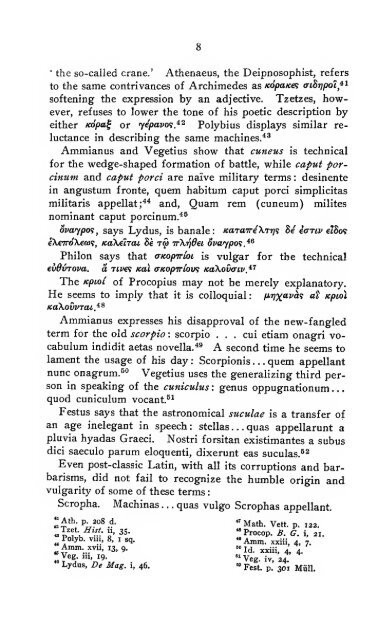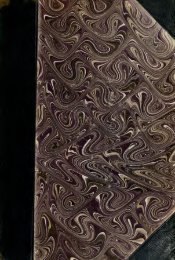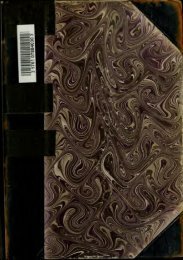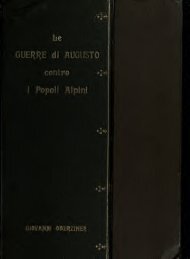Figurative uses of animal names in Latin and their ... - mura di tutti
Figurative uses of animal names in Latin and their ... - mura di tutti
Figurative uses of animal names in Latin and their ... - mura di tutti
Create successful ePaper yourself
Turn your PDF publications into a flip-book with our unique Google optimized e-Paper software.
8<br />
' the so-called crane.' Athenaeus, the Deipnosophist, refers<br />
to the same contrivances <strong>of</strong> Archimedes as KopaKe: aiSrjpoi^*^<br />
s<strong>of</strong>ten<strong>in</strong>g the expression by an adjective. Tzetzes, however,<br />
ref<strong>uses</strong> to lower the tone <strong>of</strong> his poetic description by<br />
either Kopa^ or yepavot.*^ Polybius <strong>di</strong>splays similar re-<br />
luctance <strong>in</strong> describ<strong>in</strong>g the same mach<strong>in</strong>es.**<br />
Ammianus <strong>and</strong> Vegetius show that cuneus is technical<br />
for the wedge-shaped formation <strong>of</strong> battle, while caput porc<strong>in</strong>um<br />
<strong>and</strong> caput porci are naive military terms : des<strong>in</strong>ente<br />
<strong>in</strong> angustum fronte, quern habitum caput porci simplicitas<br />
militaris appellat;** <strong>and</strong>, Quam rem (cuneum) milites<br />
nom<strong>in</strong>ant caput porc<strong>in</strong>um.***<br />
ovaypo^j says Lydus, isbanale: /caraTreXTj;? Se iariv eiS trXriOei ovaypoi.*^<br />
Philon says that aKopirioi is vulgar for the technical<br />
evdvTOva. a Tivei Kal aKOpTriow KaXovaiv.^'^<br />
The Kpiol <strong>of</strong> Procopius may not be merely explanatory.<br />
He seems to imply that it is colloquial : /iri'^avai at xpiol<br />
Ammianus expresses his <strong>di</strong>sapproval <strong>of</strong> the new-fangled<br />
term for the old scorpio : scorpio . . . cui etiam onagri vocabulum<br />
<strong>in</strong><strong>di</strong><strong>di</strong>t aetas novella.*® A second time he seems to<br />
lament the usage <strong>of</strong> his day : Scorpionis . . . quem appellant<br />
nunc onagrum.^" Vegetius <strong>uses</strong> the generaliz<strong>in</strong>g third per-<br />
son <strong>in</strong> speak<strong>in</strong>g <strong>of</strong> the cuniculus : genus oppugnationum . .<br />
quod cuniculum vocant.®^<br />
Festus says that the astronomical suculae is a transfer <strong>of</strong><br />
an age <strong>in</strong>elegant <strong>in</strong> speech: Stellas ... quas appellarunt a<br />
pluvia hyadas Graeci. Nostri forsitan existimantes a subus<br />
<strong>di</strong>d saeculo parum eloquenti, <strong>di</strong>xerunt eas suculas.^^<br />
Even post-classic Lat<strong>in</strong>, with all its corruptions <strong>and</strong> barbarisms,<br />
<strong>di</strong>d not fail to recognize the humble orig<strong>in</strong> <strong>and</strong><br />
vulgarity <strong>of</strong> some <strong>of</strong> these terms<br />
Scropha. Mach<strong>in</strong>as . . . quas<br />
:<br />
vulgo Scrophas appellant.<br />
^;^*; P- ?°8 .f " Math. Vett. p. 122.<br />
Jj-fH^st. II, 35. "Procop. B. G. i, 21.<br />
Polyb. viu, 8, I sq. " Amm. xxiii, 4, * 7.<br />
Amm xvii, »o •<br />
13, 9.<br />
jj ^^jjj<br />
Veg. lu, 19. MVeg. iv, 24<br />
Lydus, De Mag. K, 46. « Fest. p. 3oi MiiU.<br />
.



![Das Kriegswesen der Alten [microform] - mura di tutti](https://img.yumpu.com/21606999/1/167x260/das-kriegswesen-der-alten-microform-mura-di-tutti.jpg?quality=85)








